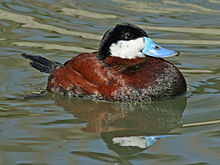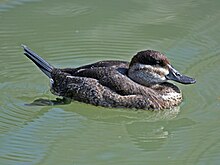Oxyura jamaicensis andina
| Ruddy duck | |
|---|---|
 |
|
| Male | |
 |
|
| Female | |
| Scientific classification | |
| Kingdom: | Animalia |
| Phylum: | Chordata |
| Class: | Aves |
| Order: | Anseriformes |
| Family: | Anatidae |
| Genus: | Oxyura |
| Species: | O. jamaicensis |
| Binomial name | |
|
Oxyura jamaicensis (Gmelin, 1789) |
|
| Subspecies | |
|
|
 |
|
|
Range of Oxyura jamaicensis jamaicensis.
Range of Oxyura jamaicensis rubida.
|
|
| Synonyms | |
|
Erismatura jamaicensis |
|
Erismatura jamaicensis
The ruddy duck (Oxyura jamaicensis) is a duck from North America and one of the stiff-tailed ducks. The genus name is derived from Ancient Greek oxus, "sharp", and oura, "tail", and jamaicensis is "from Jamaica". The Andean duck was considered a subspecies. In fact, some taxonomists, including the American Ornithological Society, still consider it conspecific. Subspecies: jamaicensis - North America including West Indies. andina - central Colombia. ferruginea - southern Colombia south to Chile.
These are small, compact ducks with stout, scoop-shaped bills, and long, stiff tails they often hold cocked upward. They have slightly peaked heads and fairly short, thick necks. Male ruddy ducks have blackish caps that contrast with bright white cheeks. In summer, they have rich chestnut bodies with bright blue bills. In winter, they are dull gray-brown above and paler below with dull gray bills. Females and first-year males are brownish, somewhat like winter males but with a blurry stripe across the pale cheek patch. In flight, ruddy ducks show solidly dark tops of the wings.
Their breeding habitat is marshy lakes and ponds. They nest in dense marsh vegetation near water. The female builds the nest out of grass, locating it in tall vegetation to hide it from predators. A typical brood contains 5 to 15 ducklings. Pairs form each year.
They are migratory and winter in coastal bays and unfrozen lakes and ponds.
These birds dive and swim underwater. They mainly eat seeds and roots of aquatic plants, aquatic insects and crustaceans.
Ruddy ducks were imported into the UK in 1948 by conservationist Sir Peter Scott. As a result of escapes from wildfowl collections in the late 1950s, they became established in Great Britain, from where they spread into Europe. By the year 2000, the population had increased to around 6,000 individuals. This duck's aggressive courting behavior and willingness to interbreed with the endangered native white-headed duck (Oxyura leucocephala), of southern Europe, caused concern amongst Spanish conservationists. Due to this, a controversial scheme to extirpate the ruddy duck as a British breeding species started; there have also been culling attempts in other European countries. By early 2014, the cull had reduced the British population to about 20–100, down from a peak of about 5500 in 2000.
...
Wikipedia

